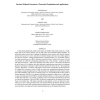Free Online Productivity Tools
i2Speak
i2Symbol
i2OCR
iTex2Img
iWeb2Print
iWeb2Shot
i2Type
iPdf2Split
iPdf2Merge
i2Bopomofo
i2Arabic
i2Style
i2Image
i2PDF
iLatex2Rtf
Sci2ools
IJFCS
2008
2008
Succinct Minimal Generators: Theoretical Foundations and Applications
In data mining applications, highly sized contexts are handled what usually results in a considerably large set of frequent itemsets, even for high values of the minimum support threshold. An interesting solution consists then in applying an appropriate closure operator that structures frequent itemsets into equivalence classes, such that two itemsets belong to the same class if they appear in the same sets of objects. Among equivalent itemsets, minimal elements (w.r.t. the number of items) are called minimal generators (MGs), while their associated closure is called closed itemset (CI), and is the largest one within the corresponding equivalence class. Thus, the pairs - composed by MGs and their associated CIs - make easier localizing each itemset since it is necessarily encompassed by an MG and an CI. In addition, they offer informative implication/association rules, with minimal premises and maximal conclusions, which losslessly represent the entire rule set. These important concep...
| Added | 12 Dec 2010 |
| Updated | 12 Dec 2010 |
| Type | Journal |
| Year | 2008 |
| Where | IJFCS |
| Authors | Tarek Hamrouni, Sadok Ben Yahia, Engelbert Mephu Nguifo |
Comments (0)

